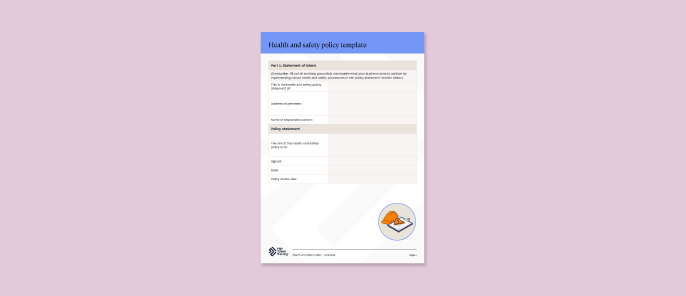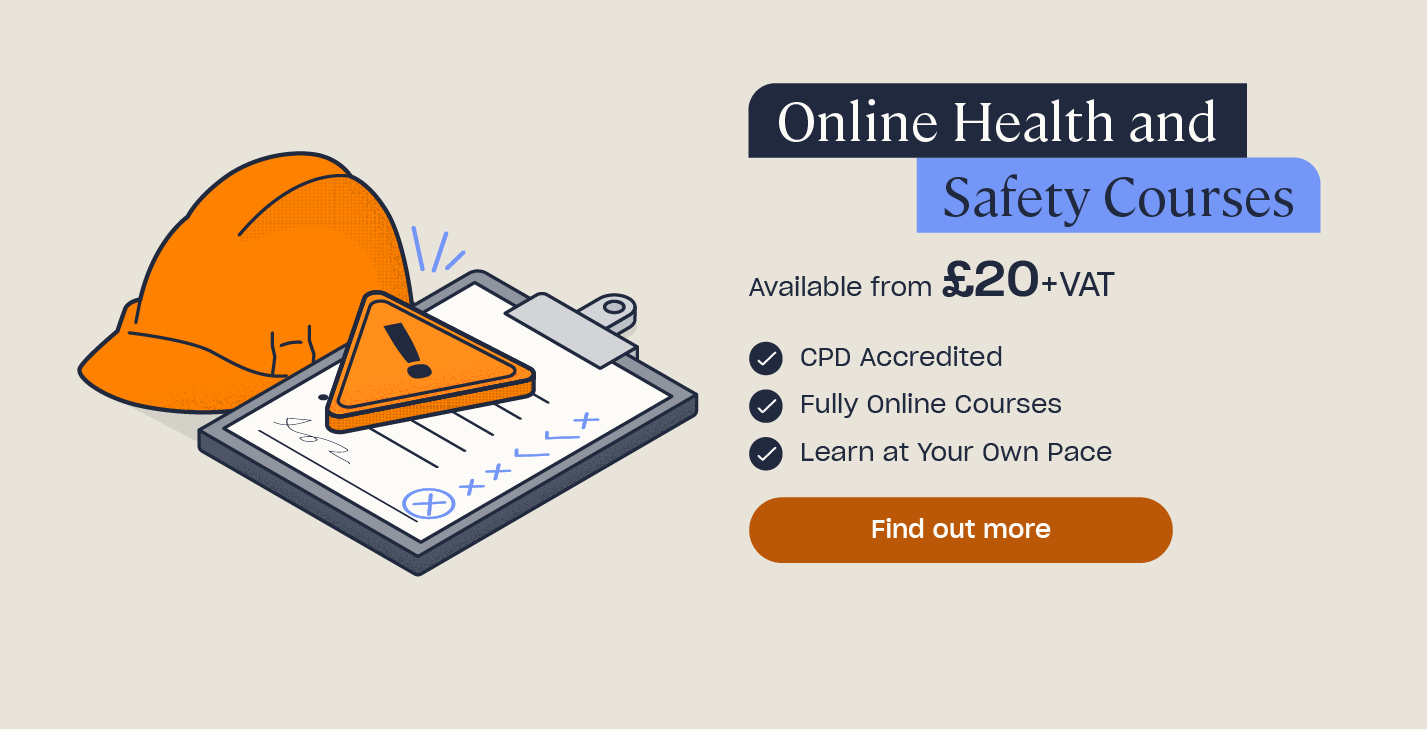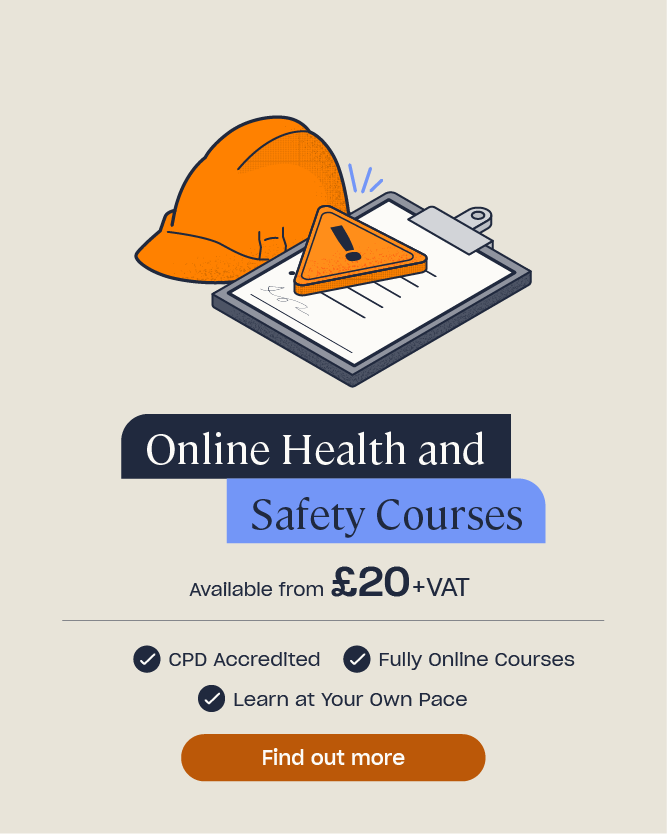Health & Safety Policy: Free Template
For business owners, writing an effective health and safety policy is not only a legal requirement but also an important step in protecting employees from harm. Workplace health and safety should never be overlooked as it plays a vital role in preventing accidents, ensuring legal compliance and enhancing workplace wellbeing and productivity. In this article, we’ll explain what a health and safety policy entails, why it’s so important that your organisation has one and provide some practical guidance on how to create a health and safety policy that’s tailored to your individual workplace. You can also download a free health and safety policy template at the end of this article.
What is a Health and Safety Policy?
A health and safety policy is a written document that outlines your organisation’s general approach and overall commitment to health and safety in the workplace. It’s a tailored document that contains information relevant to your individual business, so each aspect of it needs to be carefully considered and not just copied and pasted from elsewhere.
A well-considered health and safety policy should explain how employers and business owners will manage health and safety risks in your specific workplace, clearly outlining who has responsibility for what, how risks will be managed and what control measures should be in place to keep people safe from harm.
When written thoughtfully and applied to everyday working life, a health and safety policy will help to reduce accidents and injuries, minimise hazards and ensure legal compliance.
Who Creates the Health and Safety Policy in the Workplace?
The workplace’s employer or business owner has overall responsibility for health and safety and so must ensure that a health and safety policy is created. They are known as the ‘responsible person.’ However, the employer or owner doesn’t have to create the policy themselves, and can instead appoint a competent person to put the policy together for them.

The Management of Health at Safety at Work Regulations 1999 state that business owners should select ‘one or more competent persons’ to assist with health and safety compliance. This person could be someone within the workplace who has extensive experience and knowledge of its health and safety hazards, or it could be someone external. Generally speaking, the higher the level of risk in your workplace, the higher the level of competence required.
Who Needs a Health and Safety Policy?
By law, all types of organisations, workplaces and settings need a health and safety policy. It doesn’t matter what industry you work in, how many employees you have or what level of risk is present in your workplace.
It’s only a legal requirement under the Health and Safety at Work etc. Act 1974 for workplaces with five or more employees to keep a written record of their health and safety policy. However, it’s recommended that everyone does so regardless of their organisation’s size, as having a documented health and safety policy is considered good practice and helps to better manage risks, even for very small businesses.
Policies and Procedures for Health and Safety
An effective and comprehensive health and safety policy should include information on the procedures that must be followed for:
- Workplace risk assessments
- Staff health and safety training
- Personal protective equipment (PPE)
- Safe use of machinery and equipment
- Safety measures for specific work activities
- Consultation on health and safety matters
- First aid, evacuation and emergency arrangements
- Health and safety reporting
- Auditing, monitoring and inspections
- Relevant codes of practice
The work activities covered by your health and safety policy will depend on your particular workplace, industry and work tasks. For example, you may need to include procedures for working in confined spaces, handling hazardous substances, working at height or lone working if these are activities carried out by your organisation. What’s most important is that your health and safety policy is tailored for your individual workplace.
Want to Learn More?
Our wide range of Online Health and Safety Courses provides you with all the knowledge you need to feel confident in your organisation’s health and safety procedures, whether you need to learn more about Fire Safety, Risk Assessment or Managing Health and Safety.
How to Write a Health and Safety Policy
A well-structured health and safety policy is clear, practical and updated regularly. It should be organised into three main areas, as follows:
- A statement of intent – this section is used to explain your organisation’s general approach to health and safety at work by stating your commitment and setting out your main aims. The employer or most senior person should sign and regularly review this statement to confirm that health and safety is a key priority for the business.
- Responsibilities for health and safety – this part should list who in your business is responsible for health and safety, including their names, job titles and specific duties, such as first aiders or fire wardens. This section makes it clear who does what.
- Arrangements for health and safety – this section describes the specific steps your business is taking to meet its health and safety aims. This might include risk assessments, staff training or using safety equipment. It should show how you put your policy into action.

To write and implement an effective health and safety policy, you should:
Conduct a risk assessment. Identify hazards in your workplace with a thorough risk assessment that evaluates all the risks that could harm employees, customers or visitors to the workplace. Assess the likelihood and severity of these risks and determine the control measures needed to reduce them. It may help to consult recent accident reports and industry best practices.
Draft a statement of intent. The opening section of the policy should show your company’s dedication to maintaining a safe work environment and outline its key safety objectives and responsibilities. It’s important that senior management or the employer signs the statement to demonstrate accountability and commitment.
Assign responsibilities clearly. Define the roles for health and safety within the organisation. For example, state that senior management are in charge of overseeing safety procedures and ensuring compliance, supervisors and managers will implement policies and train staff, and employees must follow guidelines and report any hazards.
Explain how the organisation will manage risks. Include procedures for reporting hazards and incidents, the safe working practices for specific tasks and your organisation’s emergency arrangements, such as fire safety and first aid.
Communicate the policy to all employees. The health and safety policy should be made available to everyone in a handbook or on the company intranet. You should also provide regular training sessions to explain the procedures and encourage staff to ask questions or raise concerns. Toolbox talks or daily briefings are a good way to keep the conversation around health and safety going.
Review and update the policy regularly. Risks are always evolving and new laws, equipment or processes are likely to be introduced regularly, so it’s wise to review your health and safety policy at least annually or following any workplace changes or incidents. Incorporate employee feedback to further enhance safety measures and keep the policy relevant and effective.
Health and Safety Policy Template
Use the link below to download a blank health and safety policy template that you can adapt for your own workplace. Remember that the content must be tailored to your own individual organisation for the policy to be effective.

Download your free health and safety policy template here:
Creating a clear and effective health and safety policy is essential for all business owners and employers responsible for workplace safety. It not only helps meet legal obligations but also protects employees from harm and contributes towards a positive working environment. By understanding what a health and safety policy involves and following practical steps to develop one, you can ensure your business is both compliant and safe.
Further Resources:
- Online Health and Safety Courses
- Personal Emergency Evacuation Plan: Free Template
- Fire Safety Policy: Free Template











